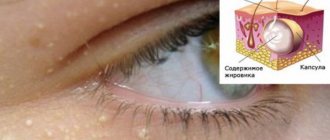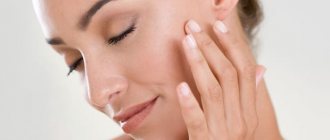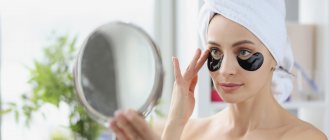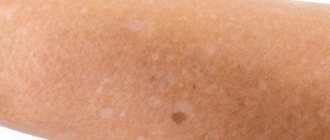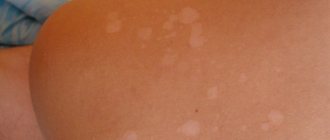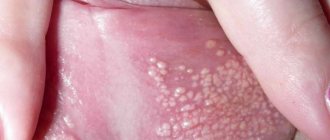White dots (pimples, spots, bumps) that appear on the face and in the eye area are called millet due to their external resemblance to millet grains. The scientific name for this skin problem is milia.
Milia appear as small white balls under the surface of the skin. They are painless, have a dense consistency and do not change their size for quite a long time.
Such formations do not pose a danger to the body, are not a sign of any disease, etc. This is just one of the types of acne that can be easily treated by a cosmetologist.
Milia on the face
Milia, which are colloquially called “milia,” appear as a result of the sebaceous glands producing too much secretion .
Such formations can be primary or secondary. Primary ones form for no apparent reason, and secondary ones are a direct consequence of skin damage (traumatic or as a result of inflammation).
The size of such formations can range from two to three millimeters .
Reference! Milia are white, dense blackheads containing sebum.
Considering that their contents do not come into contact with air, which may contain bacteria and microbes, they do not become inflamed. Although sometimes microorganisms enter through the skin, and then inflammatory processes begin .
Is it possible to get rid of milia on your own?
Trying to get rid of such acne at home is definitely not worth it. By squeezing or piercing them, it is difficult to achieve significant results. But getting an infection is very easy. In addition, unskilled punctures often leave scars and cicatrices on the skin. Therefore, after accurately comparing the costs of a cosmetologist and the potential costs of medications for inflammation and scars, it is better to give preference to a visit to a specialist.
All you can do at home is keep your skin clean and learn how to choose the right cosmetics.
Milia on the face: photo
In the photo below you can see what milia look like on the face. They can appear not only on the face, but also on the eyelids, under the eyes, and on the nose.
Treatment of milia
Milia do not go away on their own; it is almost impossible to get rid of them with the help of cosmetics. Under no circumstances should you squeeze out milia yourself, as this will damage the hair follicle and sebaceous gland. Such self-medication often leads to the subsequent formation of a larger acne or the addition of an infection, which can cause the formation of a rough scar.
Treatment of milia is carried out by a dermatologist and consists of opening and removing the cyst capsule with its contents. The choice of removal method depends on the location, number, size and depth of the milia. For single milia, mechanical removal is carried out (using a sterile needle and curettage) with preliminary and subsequent antiseptic treatment of the skin. Small wounds left after such a procedure heal on their own without leaving a trace.
For multiple whiteheads, modern methods are used - removal of milia with a laser, radio wave method or electrocoagulation. The crusts formed at the cauterization site disappear on their own within 10-14 days. Removing more than 10 elements at one time is not recommended to avoid significant trauma to the skin and disruption of the sebaceous glands.
Causes
Contrary to popular belief, milia are not acne , which are typical for people at puberty.
Attention! These formations are equally common in both young and older people. Formations arise for the following reasons:
- too much sun exposure ;
- disorders in the hormonal system;
- poor or unhealthy diet ;
- genetic predisposition;
- lack of vitamins;
- disturbance in the metabolic ;
- alcohol abuse;
- smoking;
- clogging of pores when using cosmetics;
- liver diseases.
Also, the appearance of such formations can be caused by improper functioning of the gastrointestinal tract and diseases of the pancreas.
Causes
Milia occur in patients with a thick form of oily seborrhea, characterized by hyperfunction of the sebaceous glands and changes in the chemical composition of sebum and creating a favorable background for the development of acne.
There are closed comedones - whiteheads (milia) and open comedones - blackheads (blackheads). Thick seborrhea is also characterized by the appearance of deep cysts of the sebaceous glands - atheromas and acne vulgaris. Milia have the appearance of small rounded dense nodules of a white-yellowish hue, 0.5-3 mm in size with clear boundaries, protruding above the surface of the skin and resembling millet grains (popular name - “millet”). Milium is characterized by an uninflamed head, since the whitehead does not have a natural outlet and contact with the environment. Milia do not change in size for a long time. When microorganisms enter the milium, inflammation may develop with the formation of an abscess. Milia (milia) can often be found on the wings of the nose in recently born babies; they are considered borderline conditions in newborns and soon disappear spontaneously without any treatment.
Milia are recognized based on an examination of the skin by a dermatologist-cosmetologist based on characteristic external signs.
Milia on the face: how to get rid of them
There are several ways to remove milia. They differ both in the complexity of the process and in cost.
Removal
Mechanical removal of milia is the simplest and most popular method, which is performed by a cosmetologist .
Before the procedure, the specialist cleanses the skin to avoid the possibility of infection, then makes a puncture and removes the contents of the acne .
This procedure should not be performed independently, since in some cases milia are very small in size, and when removed, a person can affect not only the milia itself, but also healthy tissue.
Whitehead Removal
To remove such a skin problem, a specialist may offer several cleaning procedures to choose from:
- Laser coagulation (painless treatment of problem areas using a laser).
- Mechanical removal (violation of the integrity of the eel using a sterile needle, squeezing out the contents).
- Electrocoagulation (exposure to problem areas with alternating current using an electrocoagulator needle).
Treatment of such “problems” by a cosmetologist guarantees their rapid disappearance and the absence of relapses if hygiene rules are followed.
Why do they appear?
As already mentioned, there are no sebaceous glands on the tongue, so “pimples” cannot appear on it in principle. After all, a pimple is an inflammation of the sebaceous gland. But the bumps and nodules that sometimes appear on the surface are very similar in appearance to pimples, which is why they got that name. Pimples under the tongue or on the tip cause a lot of trouble and are extremely painful. Let's consider the reasons for their appearance.
Mechanical damage
Often, in the process of chewing or biting food, we bite our tongue, resulting in a slight mechanical injury. The risk of surface damage increases when consuming hard foods with sharp edges (crackers, chips, seeds). A small painful swelling or bump forms at the site of the injury, which after some time turns into a white pimple. The pain intensifies while eating. With severe mechanical damage, slight swelling may occur.
You should exclude spicy and hot foods from your diet, carefully monitor oral hygiene, and after a few days the pimple will disappear on its own.
Allergic reaction
The appearance of pimples on the tongue may indicate an allergic reaction to food, medicine or toothpaste. In this case, small white pimples and sores form, which hurt and irritate when eating or drinking liquid.
If your doctor suspects an allergy, it is very important to identify the allergen and eliminate it from your diet. First of all, you should stop chewing gum, change toothpaste and tooth elixir - you may be allergic to oral hygiene products. If these measures do not bring the desired result, you need to analyze whether you have recently taken medications. Pimples on the tongue after antibiotics and other medications are a common occurrence. In this case, you should consult your doctor and stop taking the drug or try replacing it with another one.
If the cause of acne is a food allergy, you need to track what foods they appear after and eliminate these foods from your diet.
Stomatitis
Stomatitis is a common cause of white or red pimples on the surface of the tongue. The main cause of stomatitis is insufficient oral hygiene, exposure to pathogenic bacteria on the mucous membranes due to dirty hands, unwashed fruits and vegetables. Most often, children suffer from stomatitis, because they tend to put everything in their mouth.
With stomatitis, small white, pink or red pimples appear on the surface of the tongue and other mucous membranes of the mouth, which burn, irritate and hurt not only during eating, but also at rest. It is sometimes difficult not only to eat, but also to talk or simply swallow saliva. Small pimples under the tongue or at the root cause severe discomfort.
At the first suspicion of stomatitis, you should consult a doctor, he will prescribe medications that relieve itching and soreness of the tongue, as well as promote the speedy healing of ulcers and pimples.
Herpes
The herpes virus most often affects the area around the lips. However, this is not the only place where it is localized; herpes can affect all mucous surfaces of the human body, including the oral cavity. In this case, one or more watery pimples may appear on the tongue and inner surface of the cheeks. Many people do not pay enough attention to the herpes virus, believing that it will go away on its own. In fact, this is not such a harmless disease.
Without proper treatment, herpes can eventually affect the entire body, including the brain. Therefore, if you have a herpes virus, you should consult a doctor and undergo a course of antiherpetic therapy.
Poor nutrition
If you eat too much spicy and hot food, inflammation of the tongue, or glossitis, may occur. The papillae on the surface of the tongue are constantly irritated by hot or spicy foods, which leads to their inflammation. If your diet constantly contains spicy foods, inflammation can become chronic.
Drinking alcohol in large quantities, as well as smoking, can cause inflammation of the tongue. Therefore, when the first problems appear, you should immediately try to get rid of bad habits.
Pathologies of the patient's internal organs
Pimples on the surface of the tongue can be a manifestation of various diseases, including candidiasis or tuberculosis. Therefore, you should not take the appearance of small pimples lightly. Be sure to monitor their behavior. If a pimple does not go away for a long time, be sure to consult a doctor.
Weakened immunity
If the immune system is weakened as a result of a previous illness or due to a lack of vitamins and microelements, small painful pimples may appear on the surface of the tongue. If there are no other reasons for their appearance, you should contact an immunologist to check the state of the immune system. If malfunctions are detected in its functioning, it is necessary to take immunomodulators, as well as drugs with lactobacilli to normalize intestinal function and correct the activity of the immune system.
Prevention of milia
To prevent the appearance of milia, careful facial skin care is required using cleansers and moisturizers appropriate to the skin type, scrubs, peels, cosmetic masks that normalize the activity of the sebaceous glands; elimination of provoking factors, proper and rational nutrition, healthy lifestyle. Salon cosmetic procedures, including mechanical, ultrasonic, vacuum facial cleansing, peelings (chemical, mechanical - microdermabrasion), laser resurfacing, are quite effective in preventing the appearance of milia.
Location: at the tip
A white pimple on the tip of the tongue can appear at the site of a microtrauma as a result of an infection entering the wound. Fans of chips, seeds, pistachios and other nuts are especially susceptible to developing pimples on the tip of the tongue. Solid foods scratch the delicate tip of the tongue, causing pathogenic bacteria to enter the wound, causing it to become inflamed and painful.
Often a pimple occurs due to an exacerbation of the herpes simplex virus against the background of decreased immunity. In this case, strengthen your immune system and take vitamin complexes. But in any case, consult a doctor and get tested to make an accurate diagnosis.
Also, a pimple can pop out due to chronic stomatitis. If the patient has a weakened immune system and has carious teeth, persistent infection in the oral cavity sooner or later leads to stomatitis. Without timely treatment, it can become chronic, periodically exacerbating.
Location: on the base
Pimples at the base of the tongue interfere with swallowing and even speaking, they hurt and cause a lot of trouble. The reasons for their appearance can be very diverse. It could be stomatitis, a fungal infection, a sore throat or pharyngitis. Only an experienced doctor can make a correct diagnosis. We can only suggest what you should pay attention to.
If a pimple appears on the base of the tongue, you should carefully analyze other symptoms - fever, enlarged lymph nodes, the presence of allergic reactions. For example, with a sore throat, pimples form in the throat quite often. They are painful, make swallowing difficult and cause pain when talking. In this case, the patient also has enlarged tonsils and submandibular lymph nodes, and an elevated temperature. As a matter of fact, acne and fever almost always occur either with a sore throat, or with tonsillitis or pharyngitis.
It is undesirable to ignore pimples on the tongue near the throat, since in particularly advanced cases they can interfere with breathing, which can lead to suffocation. Therefore, having discovered them in yourself, you need to contact an ENT specialist for a diagnosis.
Pimples on the penis in a child
This alarming symptom in a child may indicate simple heat rash. During the hot season, due to increased sweating, children's delicate skin becomes irritated, causing small pimples to appear.
A more dangerous cause is intestinal mycosis. This manifestation is also characteristic of a very contagious disease - frequency. Only a doctor can identify the specific cause, so first of all the child must be shown to a specialist.
Preventing rashes
In order to protect yourself from the occurrence of rashes on the penis, you should adhere to a number of rules:
● it is very important to observe the rules of personal hygiene, take a shower periodically, use exclusively personal hygiene items, and change your underwear frequently;
● avoid diaper rash and sweat accumulation in the groin;
● select suitable underwear;
● use special moisturizing creams, avoid dryness of the groin area;
● when visiting public saunas, baths, swimming pools, gyms, try to minimize contact with common objects and go only to places where a sufficient level of sanitation is maintained;
● exclude promiscuity and use barrier contraception;
● lead a healthy lifestyle, eliminate bad habits, eat a balanced diet;
● regularly undergo preventive examinations for diseases and infections.
